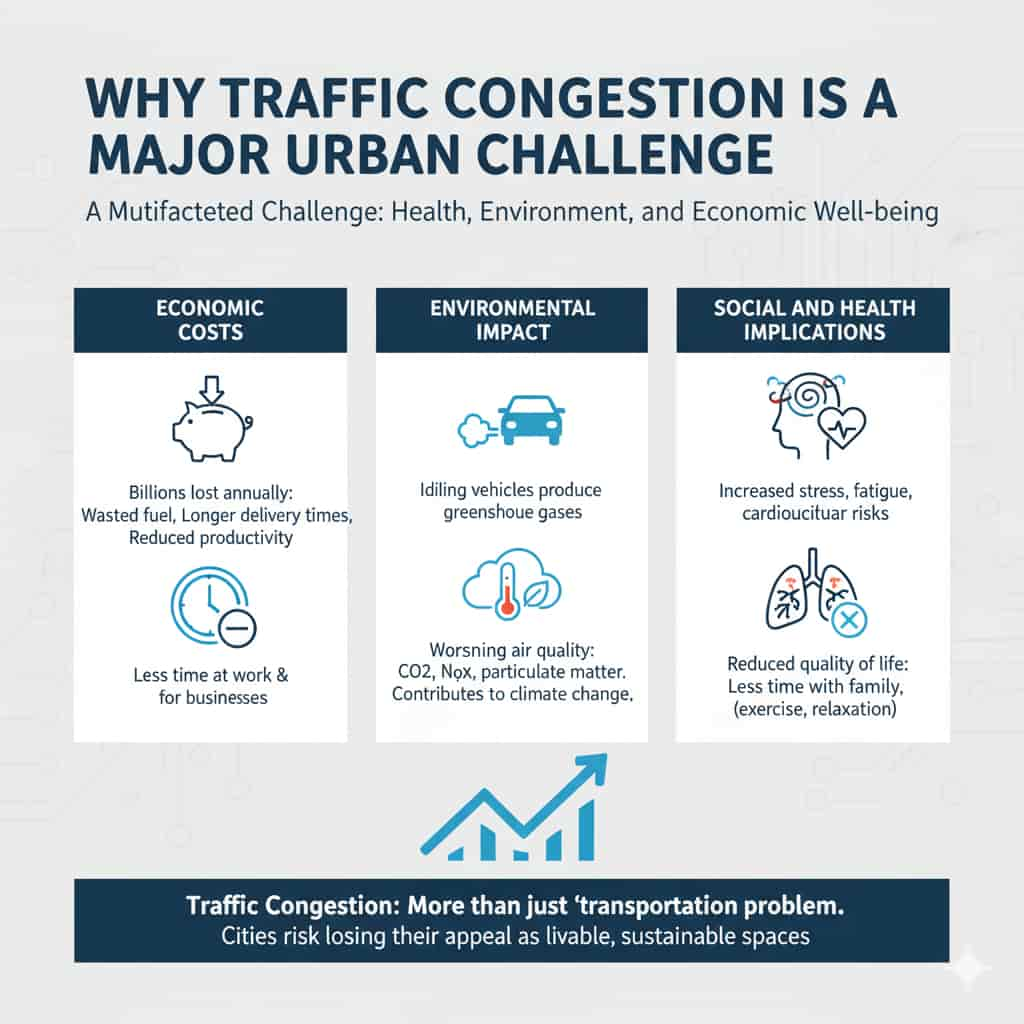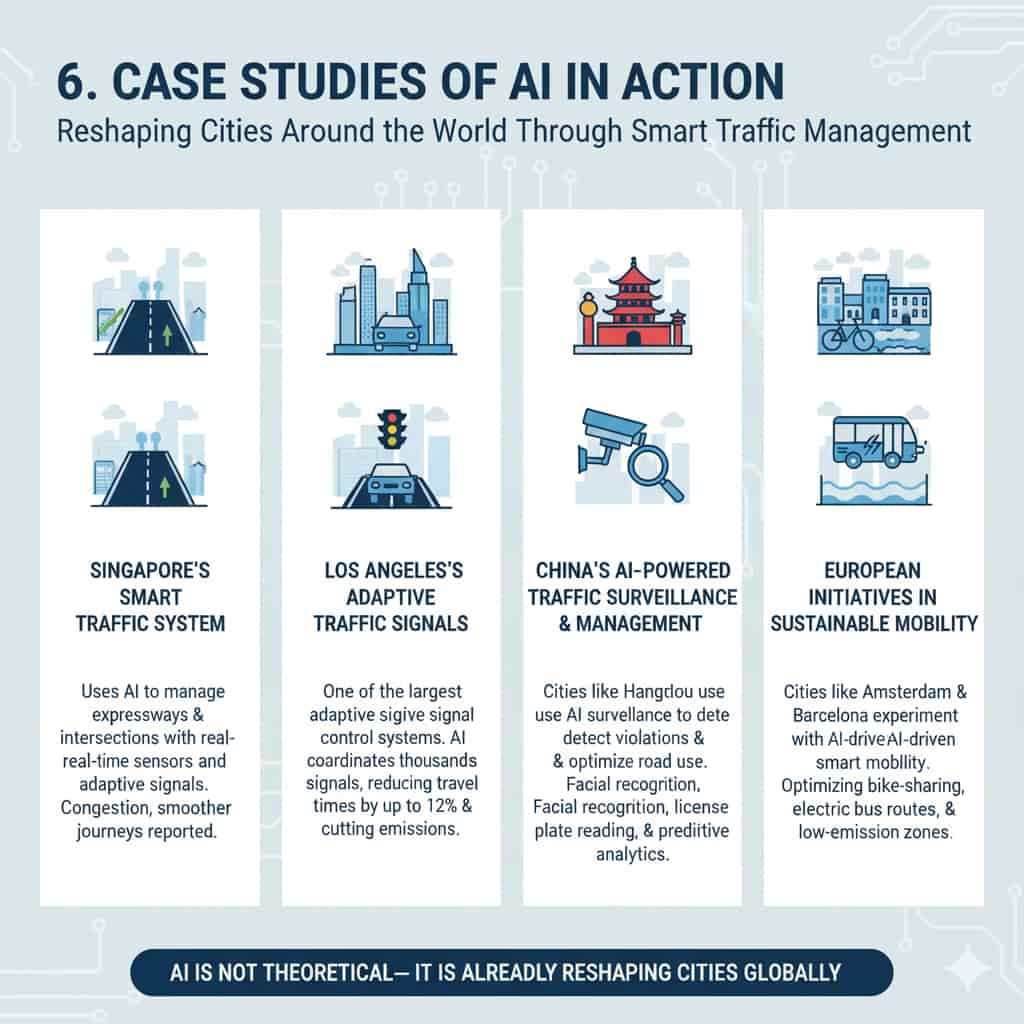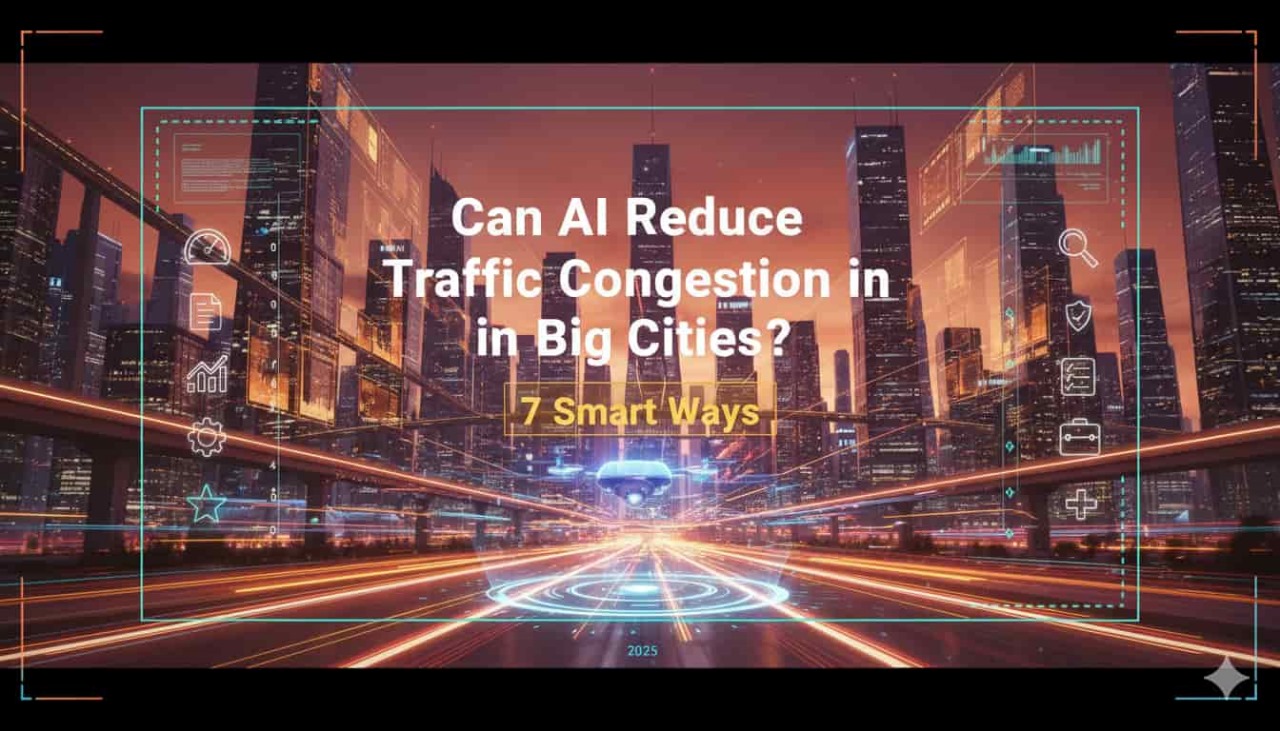1. Introduction
Loud, continuous, and frequently debilitating, traffic symptoms are like the beating heart of any large city. However, cities have a genuine opportunity to transform chaos into order with the development of artificial intelligence. AI has the potential to change how cities function by combining data, technology, and astute decision-making.
2. What is AI in Urban Traffic Management?
The use of sophisticated algorithms, data analytics, and machine learning tools to track, forecast, and optimize the movement of people and cars in urban areas is known as artificial intelligence in municipality traffic management. AI adds real-time intelligence to the system, replacing the need for manual monitoring, static maps, and conventional traffic lights.
Imagine it as providing a “brain” to cities. This brain gathers data from a variety of sources, including smartphones, GPS units, cameras, and sensors placed in the road. After the data is collected, AI analyzes it to find trends and patterns that people might overlook. For instance, it can modify traffic signals when an accident blocks a lane or anticipate an abrupt spike in traffic following a significant event.
There are numerous applications of AI in traffic management. Adaptive traffic signal control, in which lights change automatically based on actual traffic rather than according to a preset schedule, is one popular application. Another illustration is real-time traffic prediction, which predicts traffic jams before they occur by utilizing both historical and current data.
Additionally, it contributes to the optimization of public transportation by making sure that shared mobility services, buses, and trains better suit the demands of the city. AI helps cut down on crowding and wait times by evaluating passenger data. Furthermore, intelligent navigation systems direct drivers through the quickest routes, and AI-assisted incident management guarantees quicker reactions to collisions and malfunctions.
AI essentially functions as a digital conductor, continuously observing, anticipating, and modifying the cadence of urban life.
This shift doesn’t just make travel faster; it transforms mobility into something smarter, safer, and more sustainable.
3. Why Traffic Congestion is a Major Urban Challenge
3.1 Economic Costs
It jams aren’t just an inconvenience—they drain city economies. Billions of dollars are lost annually due to wasted fuel, longer delivery times, and reduced productivity. For commuters, hours stuck in gridlock mean less time at work and fewer opportunities for businesses to thrive.
3.2 Environmental Impact
Idling vehicles produce enormous amounts of greenhouse gases. Congestion magnifies fuel consumption, releasing carbon dioxide, nitrogen oxides, and particulate matter into the air. The result is worsening air quality, which contributes directly to climate change and urban pollution crises.
3.3 Social and Health Implications
Congestion has negative effects on people in addition to the economy and the environment. Long commutes raise the risk of cardiovascular disease as well as stress and exhaustion.
Asthma and other respiratory conditions are made worse by poor air quality. Congestion lowers quality of life on a social level because it takes up time that could be spent relaxing, exercising, or with family.
Not only is traffic congestion a “transportation problem,” but it is a complex issue that affects economic, environmental, and health well-being. Cities that ignore it run the risk of losing their allure as sustainable, livable places.

4. How AI Can Help Reduce Traffic Congestion
4.1 Real-Time Traffic Prediction
AI uses humanistic discipline and live data to predict traffic patterns. For example, it can anticipate congestion after a sports event and recommend alternate routes. This predictive ability helps cities plan responses before job escalate.
4.2 Adaptive Traffic Signal Control
Traditional traffic lights operate on fixed timers, regardless of changing conditions. AI-based adaptive signals analyze traffic flow in real time and adjust accordingly, reducing unnecessary waiting time period at intersections and keeping conveyance moving efficiently.
4.3 AI-Enabled Public Transportation Optimization
AI helps balance supply and demand in buses, subways, and ride-sharing systems. By tracking rider numbers and predicting peak times, cities can allocate matter more effectively, reduce overcrowding, and promote commuters to choose public transit over private cars.
4.4 AI-Assisted Incident and Accident Management
Mischance are a major cause of emergent traffic jams. AI-powered surveillance can detect unusual events quickly, such as stalled vehicles or collisions, and alert emergency services right away. Faster responses mean roads clear sooner, minimizing disruptions.
4.5 Smart Navigation and Route Guidance Systems
AI-powered navigation apps learn and get better over time, not just recommending routes based on traffic. They provide real-time alternatives that lessen traffic throughout the city by taking into account a variety of factors, including weather, road closures, and even driver behavior.
AI turns networks with passive traffic into ones that are responsive and dynamic. AI anticipates issues and proactively smoothes traffic rather than responding after it has already built up.
5. Benefits of Using AI in Traffic Management
5.1 Increased Efficiency and Reduced Travel Time
By optimizing signals and predicting congestion, AI cuts travel times significantly. Drivers spend less time idling, while public transit becomes more reliable.
5.2 Lower Emissions and Improved Sustainability
Reducing stop-and-go traffic directly lowers fuel consumption. This not only helps cities meet sustainability goals but also improves urban air quality.
5.3 Enhanced Safety for Drivers and Pedestrians
AI detects unusual patterns—like sudden pedestrian crossings or vehicles driving erratically—and sends alerts. This early detection prevents accidents and enhances road safety.
5.4 Data-Driven Decision-Making for City Planners
AI provides city planners with deep insights into mobility trends. Data-backed decisions lead to smarter investments, better road design, and improved long-term policies.
Overall, AI doesn’t just reduce congestion; it creates safer, cleaner, and more livable cities.
6. Case Studies of AI in Action
6.1 Singapore’s Smart Traffic System
Singapore uses AI to manage expressways and intersections with real-time detector and adaptive signals. Congestion has dropped noticeably, and commuters report smoother journeys.
6.2 Los Angeles’ Adaptive Traffic Signals
LA has one of the largest adaptive signal control systems in the world. AI coordinates thousands of signals, reducing travel times by up to 12% and cutting emissions.
6.3 China’s AI-Powered Traffic Surveillance and Management
Chinese cities like Hangzhou use AI surveillance to detect violations and optimize road use. Their grouping combine facial recognition, license plate reading, and prognostic analytics for seamless accumulation control.
6.4 European Initiatives in Sustainable Mobility
Cities across Europe, from Amsterdam to Barcelona, are experimenting with AI-driven smart mobility projects. These include optimizing bike-sharing schemes, electric bus routes, and low-emission zones.
These case studies prove AI is not theoretical—it is already reshaping cities around the world.

7. Challenges and Limitations of AI in Traffic Management
7.1 High Implementation and Maintenance Costs
Building AI-driven infrastructure requires significant investment in sensors, cameras, and cloud systems. Smaller cities may struggle to justify the cost.
7.2 Data Privacy and Security Concerns
AI relies heavily on surveillance and location data. Without proper safeguards, this raises concerns about citizen privacy and potential misuse.
7.3 Technological Limitations and System Failures
AI is powerful, but not foolproof. System errors, data gaps, or power outages could disrupt entire traffic networks, creating new challenges.
7.4 Equity and Accessibility Issues
Not all communities benefit equally. Wealthier areas may see faster deployment, while underserved neighborhoods risk being left behind.
Acknowledging these limitations ensures that cities pursue AI solutions responsibly and inclusively.
Read more: When Self-Driving Cars Become Mainstream? Best in 2025
8. How Cities Can Implement AI for Traffic Solutions
8.1 Assessing Urban Infrastructure Readiness
Before jumping in, cities must evaluate whether current infrastructure—roads, signals, sensors—can support AI systems.
8.2 Building Data Ecosystems and Smart Infrastructure
AI thrives on data. Cities must invest in IoT devices, connected vehicles, and cloud platforms to collect and process real-time information.
8.3 Partnering with Tech Companies and Startups
Collaboration with private-sector innovators accelerates progress. Partnerships bring advanced expertise, funding, and scalable solutions.
8.4 Policy and Regulatory Frameworks
Governments need clear policies on data sharing, security, and ethical AI use. This ensures trust and compliance.
8.5 Engaging the Public and Ensuring Transparency
Public support is vital. Cities must communicate openly about how AI works, why it matters, and how data is protected. Transparency builds trust and acceptance.
Implementation isn’t just about technology—it’s about creating a collaborative ecosystem.
Read more: AI in Traffic Management: Reducing Congestion
9. The Future of AI in Urban Mobility
9.1 Integration with Autonomous Vehicles
AI traffic systems will eventually interact with self-driving cars, coordinating them with signals and other vehicles for seamless flow.
9.2 AI-Powered Mobility-as-a-Service (MaaS)
Future cities will combine buses, trains, bikes, and ride-sharing into one integrated, AI-powered mobility platform. Travelers will book multimodal journeys as easily as ordering food.
9.3 Role in Achieving Net-Zero Urban Transportation
By reducing congestion, promoting public transport, and integrating with electric mobility, AI can play a central role in achieving net-zero emission goals for cities.
The future points to a world where cities aren’t just smarter but also greener and more connected.
Read more: AI Traffic Systems Promise Jam-Free Cities Worldwide | WION …
10. Frequently Asked Questions
10.1 Can AI completely eliminate traffic congestion?
No, AI cannot fully eliminate congestion, but it can significantly reduce it. Some factors—like population growth and urban sprawl—will always create pressure.
10.2 How expensive is it for a city to implement AI traffic systems?
Costs vary widely. Large-scale projects can run into millions of dollars, but many cities find the savings in fuel, productivity, and emissions justify the investment.
10.3 What role does 5G play in AI-driven traffic management?
5G provides ultra-fast, low-latency connectivity, allowing AI systems to process and share data instantly. This is critical for real-time responses.
10.4 Can AI reduce emissions from vehicles in cities?
Yes. By reducing idling, optimizing routes, and encouraging public transport use, AI helps cut fuel consumption and emissions.
10.5 How secure are AI traffic management systems against cyberattacks?
Security is a real concern. Cities must invest in strong cybersecurity measures, including encryption and regular system audits.
10.6 Are AI traffic solutions applicable to smaller cities, or only megacities?
AI is scalable. While larger cities see the most benefits, smaller cities can adopt scaled-down, cost-effective systems.
10.7 What is the role of citizens in making AI traffic systems effective?
Citizens contribute by adopting navigation apps, using public transport, and respecting new traffic systems. Their cooperation is key.
10.8 How soon can we expect widespread adoption of AI in traffic systems?
Some cities already use AI extensively. Widespread adoption may take another decade, depending on funding, infrastructure, and policy readiness.
Final Thoughts
AI provides cities with a potent solution to one of their most significant problems: traffic congestion. AI has the potential to make urban transportation systems safer, greener, and faster by enabling smarter mobility, optimizing systems, and predicting patterns. Even though there are still obstacles to overcome, the future appears bright and much less crowded.


1 thought on “Can AI Reduce Traffic Congestion in Big Cities? 7 Ways”